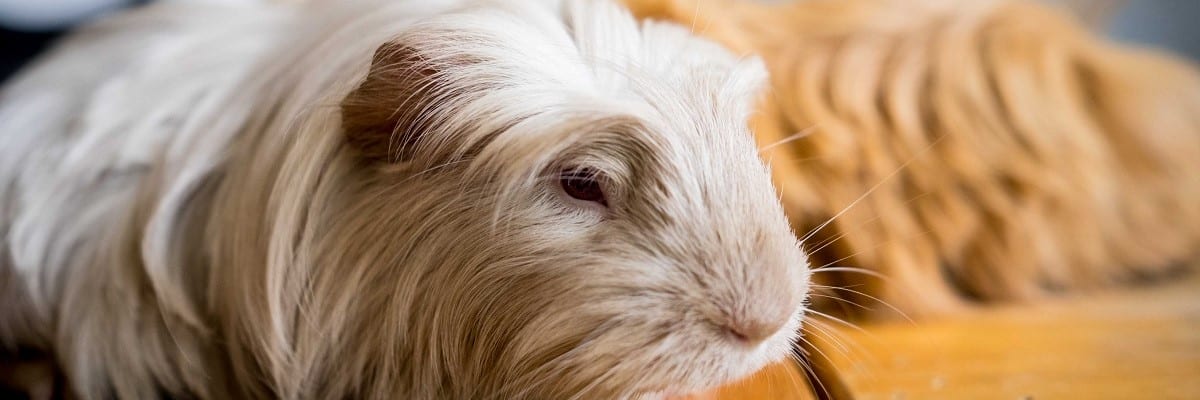When your guinea pig ages, they will be more prone to many of the same diseases that humans experience as they grow age, which include arthritis.
Recognizing what symptoms to look out for can help make sure that you get your guinea pig to the vet quickly to help ease their pain.
If you want to try some natural remedies for your guinea after speaking to your Vet, the following can help. Parsley root, Cannabidiol, Comfrey, Omega-3, Glucosamine
Arthritis affects the elderly guinea pigs and guinea pigs from the age of 12 months onward. Arthritis is often characterized by stiffness, inability to function or be as maneuverable as they once were, or being reluctant to walk, ask for food, or do physical activity as normal.
What is Arthritis And How Does It Affect Your Guinea Pig?
Arthritis is the umbrella concept for more than 100 medical disorders affecting the musculoskeletal system, specifically joints when two or more bones touch. While arthritis is very widespread, it has not been well understood.
Symptoms That Your Guinea Pig May Have Arthritis
| They Are Not As Mobile: Your guinea pig is likely to have reduced movement if it suffers from arthritis pain. As they walk around, they can seem to be limping or even skipping like a bunny. This restricts the range of movement in their back legs and buttocks. If you find it tends to be especially rigid or immovable on wet or rainy days, arthritis is possibly a diagnosis. If any of these signs are apparent, a natural veterinarian or Vet should be consulted first. |
| They have A Dirty Bottom: If your guinea pig suffering from arthritis can feel pain when they go to the toilet. Pain may conflict with their subconscious practice of coprophagy, where they eat their feces. A dirty bottom can signify a case of arthritis from either the back or the hind legs. |
| They Are Squeaking A Lot More: As arthritis causes joints to enlarge by becoming sore, and your guinea pig with this disorder can squeal or squeak to show frustration when the disorder interferes with daily routines. Going to the toilet, exercising, or even being collected for a snuggle, can elicit a painful squeak from your guinea pig, who doesn’t feel well if your guinea pig appears to be vocalizing their discomfort. |
| Personality Changes: Guinea pigs who have arthritis pain can also change their attitude depending on their illness. If a usually cuddly Guinea pig unexpectedly appears bittie, especially if you try to pick them up or stroke his buttocks. On the other hand, a standoffish guinea pig, who quickly seems to want good cuddling in a warm blanket, may appreciate the gentle textures and warmth on their joints. |

Natural Products To Help Your Guinea Pig With Arthritis
Parsley
Parsley and celery are all related. Guinea pigs are allowed to eat parsley. Parsley offers a wealth of vitamin C and other vital nutrients that your guinea pig needs. It is diuretic and rich in essential oils and nutrients (namely sodium). It is particularly relevant to joint problems, as it is a remedy for the thyroid and adrenal glands. It helps to encourage a natural inflammatory reaction at a hormonal scale and will help take away the discomfort your guinea pig is feeling.⠀
Though you must only offer it infrequently by combining it with other foods, Mis-feeding parsley may contribute to the development of bladder stones and other gastrointestinal disorders.
Little French Dog is a participant in the Amazon Services LLC Associates Program, an affiliate advertising program designed to provide a means for sites to earn advertising fees by advertising and linking to Amazon.com.
How Much Parsley Can My Guinea Pig Eat?
While parsley is fine for your guinea pig, there are restrictions! This is how much parsley to give your guinea pig:
| Age of Guinea Pig | How Much Parsley |
|---|---|
| Under 12 months | Nil |
| Over 12 months | Five sprigs every three days (though start with two and build up) |
How Much Parsley Can My Guinea Pig Eat?
If it is the first time you have given Parsley to your guinea pig, then pay more attention to their toilet patterns for the next 12 hours.
If you do not see any symptoms of intestinal discomfort or diarrhea, you should progressively raise your serving size over the next few days before getting the full portion of 5 sprigs.
Comfrey Leaves For Arthritis
Comfrey grows widely in North America, Europe, and Asia. It grows to a height of five feet. Plants with this species grow purple, blue, and white blooms, and its foliage is long, slender, and its roots are black.
Several regions of the world use the root and leaves of the comfrey plant in traditional medicine. For over 2,000 years, Japanese people have been cultivating and using the plant as a treatment.
The older name for this substance was “knitbone,” which people used to treat:
| Joint Inflammation/Arthritis | Muscle Sprains |
| Burns | Bruises |
Comfrey has been used to manage chronic inflammation like arthritis and gout in European nations. A few herbal medicine practitioners use it to treat diarrhea and abdominal cramps.
Comfrey plants contain allantoin and rosmarinic acid in their root and leaves. Rosamarinic acid relieves pain and inflammation, while allantoin promotes new skin cell growth. You can also prepare ointments, creams, and salve with roots and leaves.
How Much Comfrey Leaves Can My Guinea Pig Eat?
First off, it is recommended once again not to give them herbs every day. It is all so suggested in Comfrey leaves that you have them dried out first before feeding them to your Guinea pig.
| Typically limit comfrey to half leaf, per Guinea Pig, every to three days. Along with their normal diet. |
Again after feeding your Guinea pig something new, keep an eye on them to see if they have any adverse reactions.
Omega-3 for your Guinea Pigs Arthritis
Omega-3-rich foods fed to guinea pigs that naturally develop osteoarthritis have decreased the disorder by 50% compared to regular diets, according to research sponsored by Arthritis Research UK and reported in the journal Osteoarthritis and Cartilage.
Omega-3s have been shown to interact with immune system cells, leukocytes, and enzymes known as cytokines, all of which are important players in the body’s inflammatory reaction.
Anti-inflammatory properties of omega-3s are beneficial not only for the relief of arthritis but also for the prevention of other inflammatory conditions, such as heart disease.
Omega-3s low concentrations of unsanitary blood fats called triglycerides to minimize the growth of plaques that clog arteries, increase the levels of protective HDL cholesterol and reduce inflammation.
How Much Omega-3 Can My Guinea Pig Eat?
| Your exotic Vet best answers this as they will be able to give you a good quality Omega 3 supplement and recommend the appropriate dose. |

Glucosamine for your Guinea Pigs Arthritis
Glucosamine is a sugar that is naturally formed by the body. It’s one of the basic components of the cartilage. Cartilage protects the ends of the bones, helping the joints to move easily against one another.
Glucosamine exists in two types, glucosamine sulfate, and glucosamine hydrochloride. Glucosamine medicines are traditionally made from crab, lobster, or shrimp shells, though other products are made from glucosamine that comes from plants.
It is thought to be beneficial for mammals with arthritis where cartilage has been broken down. It is considered taking glucosamine, and chondroitin products can alleviate pain and prevent or delay cartilage breakdown.
How Much Glucosamine Can My Guinea Pig Eat?
Bear in mind that, while fast-acting prescription pain killers, glucosamine is a medication that takes effect over some time and can take a couple of weeks to start showing benefits.
| Approximately 100 mg of the is a good starting dose. Try sprinkling the powder directly on some moist vegetables like cucumber. |
Cannabidiols for your Guinea Pigs Arthritis
CBD counterbalances joint pain and swelling by functioning as an antioxidant to reduce chronic inflammation.
Research also indicates that the administration of CBD to rats decreases the experience of short-term pain. Two different reports even confirm the use of CBD in the treatment of arthritis.
CBD guinea pig creams work well on localized pain. Best results are accompanied by regular CBD supplementation for a few days to weeks.
As CBD oils can potentially come from both marijuana and hemp, you’ll want to check the labels before buying. Hemp oils (with CBD) are extracted from the plant stems.
Since the whole plant has hardly any THC except for the leaves, most CBD extracts are completely missing. However, certain human-based products known as the total-spectrum oils contain trace quantities.
Although tiny in humans, guinea pigs are also much smaller. Too much THC will affect your pig, so ensure you get only broad-spectrum or CBD-isolated hemp oils.
How Much Cannabidiols Can My Guinea Pig Eat?
| As mentioned above, CBD comes in many different varieties. It is recommended to follow the instruction on the back of the product or consult your Vet first. |

